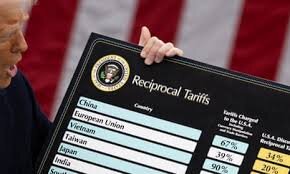Navigating Economic Turbulence and Geopolitical Challenges: The Impact of Trump’s Policies
In a rapidly changing economic landscape, Donald Trump’s sweeping tariffs are creating significant turbulence across global financial markets. These tariffs, targeting nearly all U.S. trading partners, pose a risk to the very structure of the global economy and could ignite broader trade wars.
Let’s delve into the ramifications of these tariffs and how they affect various sectors and international relations.
1. Tariff Shock: Decisions and Consequences
- Executive Details:
- Implementation method: Tariffs were enacted suddenly, without prior notice, with minimal support for affected U.S. businesses.
- Most affected sectors: The electronics sector has suffered losses amounting to $32 billion, followed by the automotive industry at $21 billion, and consumer goods with $18 billion.
- International Reactions:
- China and the European Union have lodged formal complaints with the World Trade Organization (WTO).
- Deeper Analysis of Effects:
- The banking sector has experienced losses of $42 billion from seven major U.S. banks within just one week.
- Global shipping has seen a 15% decline in container traffic across the Pacific.
- 78% of multinational supply chains have reported disruptions due to these tariffs.
2. Enhanced Strategic Dilemma
As companies navigate these turbulent waters, reshoring is a hot topic.
- Additional Data on Reshoring:
- A significant 68% of U.S. companies still plan to retain operations in Asia despite mounting pressures.
- Only 12% have initiated partial relocations back to the U.S.
- Estimated relocation costs for the private sector range from $280 billion to $320 billion.
- Expanded Energy Crisis:
- About 17% of shale oil wells have shut down due to economic challenges.
- The U.S. energy sector faced losses of $34 billion in the first quarter of 2025.
- This has resulted in a loss of 78,000 direct jobs in the energy sector.
3. In-depth Iranian File
- Expanded Military Analysis:
- The U.S. has heightened its military presence, increasing troop levels to 45,000 in the Persian Gulf.
- Iran has deployed 1,200 ballistic missiles along its coasts.
- Simulations predict that closure of the Strait of Hormuz could lead to losses of $18 billion daily.
- Disruptions in the Bab al-Mandeb Strait could threaten energy supplies, affecting global oil prices.
- New Regional Alliances:
- A mutual defense agreement between Iran and Russia was established in February 2025.
- China and Iran conducted naval exercises with Russian participation, titled “Maritime Security Belt 2025,” in March 2025.
- Trade between Iraq and Iran has increased by 37%.
4. Detailed Yemeni Disaster
- Indicators of Military Failure:
- The Yemeni Armed Forces have increased their territorial control from 80% to 85% in 2025.
- Coalition forces have lost 143 drones since January 2025.
- The conflict has resulted in 3,200 additional Saudi casualties.
- This situation marks Yemen’s success in challenging U.S. dominance in the Red Sea.
- The Yemeni Armed Forces have effectively imposed a maritime blockade on Israeli shipping through the Red Sea since November 2023.
- Economic Repercussions:
- The cost of Saudi operations during the war has reached $3.2 billion per month.
- Saudi oil production has dropped by 18%.
- Aramco’s market value has decreased by 22%.
5. Expanded Domestic Dilemma
- Political Division:
- Approximately 42% of Republican Party members openly oppose Trump’s policies.
- There are five legislative proposals aimed at limiting the president’s trade powers.
- Domestic Economic Conditions:
- The annual inflation rate has surged to 8.7%, the highest since 1982.
- The national debt has surpassed $36 trillion.
- Moody’s has downgraded the U.S. credit rating to Aa2.
6. Enhanced Geopolitical Shift
The geopolitical landscape is witnessing significant changes as new alliances form:
- China-EU Trade Agreement: This agreement covers 43% of the global economy.
- Russia-Iran-India Energy Alliance: This alliance addresses 28% of global energy requirements.
- Alternative Payment Systems: 19 countries are adopting payment systems outside of SWIFT.
In conclusion, the consequences of Trump’s tariffs are extensive, affecting various sectors and international dynamics. As the situation unfolds, it is crucial for stakeholders to remain informed and adaptable in this evolving landscape.






